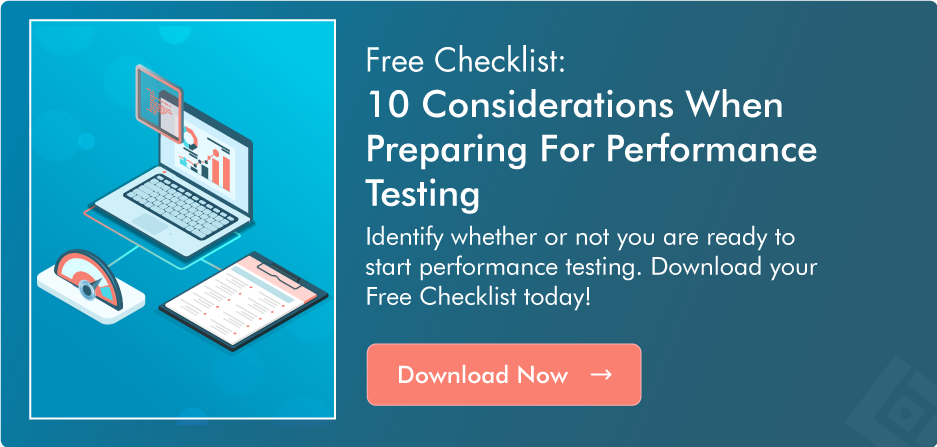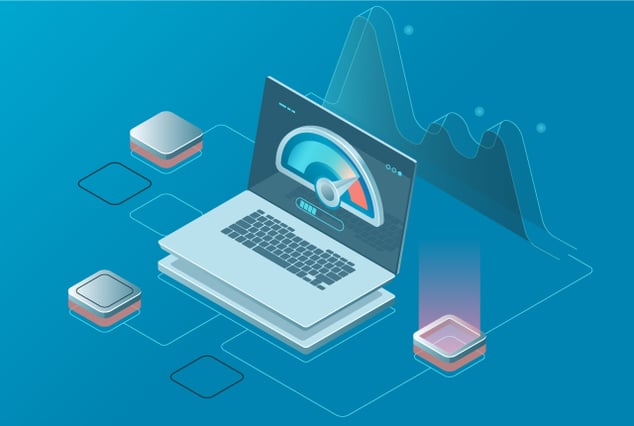
Every QA endeavor needs a plan in place. That’s because QA testing succeeds when there are set goals, established timelines, systematic processes and concrete metrics.
So why settle for less when performance testing your software application? After all, being fully prepared with a well-defined test plan can prevent delays, enhance test results and streamline your development cycle.
But what is performance testing? More specifically, what is software performance testing? And how can your team create a solid performance testing checklist so that no step is missed?
Our expert engineers at QASource weigh in on the conversation. By offering their expertise and providing a performance testing requirement checklist, you are on track to analyzing all key metrics and completing all essential tasks when testing.
What Is Performance Testing?
Performance testing is the process of examining the responsiveness, speed and stability of a hardware or software system-be it a computer, device, network, software application—under specific workload conditions. A strong performance testing requirement checklist includes tests that evaluate reliability, processing speed, data transfer rate, throughput and network bandwidth.
QA testers carry out various types of performance testing as quantitative tests in a lab or executing limited scenarios within the production environment. QA teams often rely on performance testing software to execute test cases thoroughly and to track performance testing metrics across development cycles.
So, What Is Software Performance Testing?
Software performance testing focuses on the unique task of fully testing the stability, speed and responsiveness of a software application. When devising their software performance testing checklist, QA engineers create a performance test plan for a web application that’s specific to the performance expectations of a software program.
In order to follow performance testing best practices, it’s recommended for QA teams to reassess their performance testing checklist for web applications based on received data from previous testing cycles so that their web performance checklist always targets every essential performance test case.
Performance Testing Checklist
QASource's expert engineers compiled this software performance testing checklist to guide your QA team in creating a successful performance test plan for web applications. Start your process of developing a performance testing checklist for web applications by following these steps designed to resolve potential testing issues before they occur:
-
Identify The Load Testing Objective
Is it your goal to test the performance of an application during peak load times or to test the stability of an application under a heavy load? These goals are crucial to define when shifting from performance testing to performance engineering.
A peak load time is a duration of time when the application receives more requests than usual, either during a specific time of day (such as 10AM and 5PM) or on specific days of the year (such as New Year’s Day or Black Friday). To test this, QA testers simulate the experience of a peak load time and collect performance testing metrics in order to analyze the software’s performance.
Testing heavy loads is not reliant on expected load cases, even during peak times. Instead, heavy load testing evaluates how the software application maintains stability when the software system unexpectedly receives a high volume of requests.
Performance testing best practices recommends including both types of performance testing within your performance testing requirement checklist. That way, your QA team can confirm that your software application can handle high-volume loads during expected peak times of day and during unanticipated events.
-
Determine Which Type of Application Requires Performance Testing
To create a web performance checklist, your team must first know which type of application is to be tested. Without establishing this, your performance test plan for web application may be too broad or irrelevant to the software system that needs testing.
Ask yourself these questions when developing your performance testing checklist:
- Is the application web-based, a desktop application or a mobile app?
- What is your application’s operating system?
- Which environments are available for testing?
- What performance testing software is available to you for testing this application?
A well-defined test plan can prevent delays and resolve issues before they happen.
Your performance testing checklist for web applications should provide answers to these key questions:
- Are the priority of APIs scenarios defined?
- Are all positive and negative test scenarios included?
- How are test scenarios to be assigned across your QA team?
-
Identify The Special Software or Plug-Ins
Special software and plug-ins often require specialized performance testing software in order to test them successfully. A test plan focused on how to test the special software or plug-in during your performance testing process is necessary. They may require outside resources for assistance, be it reviewing manuals and written guides to consulting with software testing experts.
Does the application have any special software or plug-ins involved? Does the application use 'Flash Player' or 'Java Swing Objects'? Performance testing software designed for testing plug-ins can easily adapt to these complex configurations without losing time in executing test cases. Make sure your web performance checklist includes the implementation of these testing tools within your testing process.
-
Identify Specific Key Performance Indicators (KPIs)
Establishing performance testing metrics guides your QA team through the process of testing performance. Choose your key performance indicators wisely, because these KPIs are designed to monitor application server metrics, response times, database server metrics and system behavior.
So, what are the recommended KPIs in order to follow performance testing best practices? When carrying out all types of performance testing, we suggest targeting these performance metrics every QA team should track:
- Response Time: How long does it take to send a request and receive a response?
- Wait Time: How long does it take to receive the first byte once a request is sent?
- Peak Response Time: What is the longest amount of time it takes to fulfill a request?
- Error Rate: What percentage of requests result in errors in comparison to all sent requests?
- CPU Utilization: How much time does the CPU need to process requests?
Next Steps for Your Performance Testing Checklist
Want more guidance? Check out our performance testing requirement checklist 10 Considerations When Preparing For Performance Testing designed to help an engineer, testing provider and/or a software company start the performance testing process. This web performance checklist below dives into every 10 step you must follow when preparing to test an application's performance.
Need more resources to make this happen? You have the option of partnering with a professional QA services provider like QASource. Our team of testing experts are skilled in client-side performance testing and can help you create a strong performance testing checklist for your software application.
Get in touch with a QASource expert today.
Download your free checklist below and discover the steps that need to be completed when preparing for performance testing.



